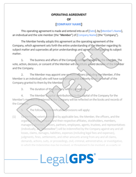Startup IP Protection: Your Comprehensive Guide to Safeguarding Assets
Startups are the lifeblood of innovation, powering economic growth through their disruptive ideas and solutions. However, in the race to market, many...
7 min read
LegalGPS : Oct. 14, 2024
If you've successfully filed a trademark application, congratulations—you've completed an important step in securing your brand. But to maintain your trademark's active status, you need to file a Statement of Use (SOU). Filing your SOU is essential to demonstrate that you're actually using your trademark in commerce. Missing this step could mean losing the protection of your valuable mark and all the effort you put into getting it approved.


Legal GPS Pro
Protect your business with our complete legal subscription service, designed by top startup attorneys.
A Statement of Use is a form that tells the United States Patent and Trademark Office (USPTO) that you are actively using your trademark in the marketplace. Essentially, it proves that the trademark isn't just an idea but something your customers can see in connection with your goods or services. Filing a Statement of Use turns your application into a real-world brand that customers can interact with. To complete this form, you'll need to provide the following:
The date the mark was first used for anything: This could be internal company use, such as creating branding materials or prototypes.
The date the mark was first used in commerce: This refers to when goods or services bearing the trademark were first sold or provided to customers.
A signed declaration: This is your official statement that all the information you're providing is accurate and truthful.
A specimen showing how the trademark is used: This is key evidence that the trademark is actively being used in commerce.
A filing fee: The fee amount may vary, so make sure you have the most current information from the USPTO.
Filing this form correctly ensures your trademark stays protected and enforceable.
A specimen is a sample showing how your trademark is being used with your goods or services. Think of it as proof that your trademark isn't just on paper—it's visible to your customers in real-world scenarios. A specimen must show your trademark in a way that connects it to the goods or services you provide. The type of specimen you submit will depend on whether you provide goods or services.
If you sell goods, you'll need to submit a specimen that shows the mark directly on the product or its packaging. Here are some detailed examples:
Clothing Tags and Labels: If you sell clothing, a photo of the tag or label with your logo attached to the clothing is a perfect specimen. Make sure the tag is clear and that it’s obviously part of the product. For example, if you sell t-shirts, take a photo of the logo tag as it is sewn into the shirt.
Packaging: If you sell physical products that come in packaging, a picture of the product’s box or wrapper with your logo is ideal. For instance, if you sell artisanal candles, the box your candle comes in—with your logo prominently displayed—can be used as a specimen.
Product Photos: If your trademark is printed directly on the physical product, a photo of the product itself showing the mark is suitable. For example, a company that produces water bottles can submit a photo showing the trademark logo on the bottle.
User Manuals or Inserts: If your product comes with a user manual or an insert that includes your trademark, that can also serve as an acceptable specimen.
Secure Your Startup’s Brand and Inventions
If you provide services, you need to show your mark as it's used in connection with those services. Here are a few examples:
Brochures and Flyers: Submit a brochure or flyer where your trademark appears along with a description or pricing of your services. For example, if you provide consulting services, a brochure that describes your services and prominently displays your trademark is an excellent specimen.
Website Screenshot: A screenshot of your website showing your trademark next to the description of your services is a common specimen for service providers. Make sure that the screenshot includes the trademark and an explanation of the services you offer. For instance, if you run a digital marketing agency, a screenshot of your “Services” page with your logo is a good specimen.
Advertisements: Any ads—whether printed or digital—featuring your trademark alongside information about your services can be used. For example, an online ad that lists your services with your logo is a good example of how your trademark is used in commerce.
Business Cards or Stationery: If your trademark appears on business cards or official stationery that you use in providing your services, these can also be suitable specimens. For example, a real estate agent could use a business card that has the trademarked logo along with the services they offer.
The main requirement is that the specimen must clearly link your trademark to the goods or services you're providing, so your customers can easily identify your brand.
If you’re not sure if your specimen meets USPTO standards, the USPTO provides clear, actionable guidance on their website. It’s always good to double-check before submitting to avoid rejection.
After your trademark application is approved, you have six months to file your Statement of Use. If you can't meet this deadline, you can file for an extension—but keep in mind that an extension only lasts for an additional six months and requires a fee. You can file for up to five extensions, giving you a total of 36 months if needed. However, after the first extension, you will also need to show that you are making an "ongoing effort" to use the trademark in commerce.
Pro Tip: Set reminders for important trademark filing deadlines. Missing these deadlines can be costly and may jeopardize your trademark rights.


Legal GPS Pro
Protect your business with our complete legal subscription service, designed by top startup attorneys.
Sometimes, you may need more time before filing your Statement of Use. Here are some common reasons to request an extension:
You Haven’t Used the Mark in Commerce Yet: Perhaps you're still in the product development phase and haven't begun sales. For example, you might be waiting for product manufacturing to complete or are conducting market tests before launching your product.
You Don’t Have a Suitable Specimen: Creating acceptable materials that meet USPTO standards might take time. For example, if you’re rebranding your product packaging, you may need extra time to finalize the design and start using it in commerce.
You Need the Filing Fee: The financial aspect can be challenging, especially for startups. An extension gives you extra time to gather the necessary funds to cover filing fees.
Each extension request requires a fee, so it’s essential to plan accordingly and try to meet the initial deadline if possible. Without a properly filed Statement of Use, you cannot obtain final trademark registration, which is just as important as the initial trademark application itself. Don't let all your hard work go to waste—make sure you file on time.
Filing your Statement of Use with the USPTO may seem daunting, but breaking it down into actionable steps can make the process much smoother. Here’s a detailed guide on how to file your Statement of Use effectively:
Before you begin the filing process, ensure you have all the required details and documents. This includes:
Dates of Use: Make sure you have the exact dates when your trademark was first used anywhere and first used in commerce. This information is crucial for proving the timeline of your trademark usage.
Specimen: Collect a specimen that clearly shows how you use the trademark in connection with your goods or services. Review the examples provided earlier to ensure you have an acceptable specimen.
Filing Fee: Verify the current filing fee on the USPTO website and make sure you have the funds ready. The fee can vary depending on your specific filing circumstances.
The USPTO uses an online filing system called the Trademark Electronic Application System (TEAS). To file your Statement of Use:
Visit the USPTO Website: Go to the USPTO website (uspto.gov) and navigate to the TEAS page.
Select the Correct Form: Choose the “TEAS Statement of Use” form. Make sure you select the correct option to avoid delays or mistakes in processing.
Log In: You will need to log in or create an account if you don’t already have one. Having an account allows you to track the status of your filings.
Once logged in, you will need to fill out the Statement of Use form. Here’s what you’ll need to do:
Provide the Required Dates: Enter the dates when you first used the trademark anywhere and when you first used it in commerce.
Upload Your Specimen: Attach the specimen that demonstrates your use of the trademark. Make sure the image or document is clear and meets the USPTO requirements.
Fill in the Declaration: Complete the declaration section by confirming that all the information provided is accurate. This section serves as a legal affirmation of your statements, so double-check for any errors.
After completing the form, you will be prompted to pay the filing fee. The fee can be paid online using a credit card, debit card, or electronic funds transfer. Ensure your payment method is ready before starting the filing process to avoid any interruptions.
Before you submit the form, carefully review all the information you’ve entered. Errors or omissions can lead to delays, rejections, or even the loss of your trademark rights. Look over each section, paying particular attention to:
Dates of Use: Ensure accuracy.
Specimen Quality: Verify that the specimen is clear, correctly labeled, and meets the USPTO guidelines.
Contact Information: Make sure your contact information is correct so you can receive updates from the USPTO.
Once you’re satisfied that everything is accurate, click “Submit.” You will receive a confirmation receipt—save this for your records.
After submission, keep track of your Statement of Use status. You can do this by logging in to your USPTO account. The USPTO may reach out if they need further information, so be sure to check your email regularly for any correspondence.
Pro Tip: Filing early can give you some breathing room in case the USPTO requests additional information or if there are any issues with your submission. Being proactive can prevent unnecessary delays in the registration process.
The biggest question now is, "Do I need a business lawyer?” For most businesses and in most cases, you don't need a lawyer to start your business. Instead, many business owners rely on Legal GPS Pro to help with legal issues.
Legal GPS Pro is your All-In-One Legal Toolkit for Businesses. Developed by top startup attorneys, Pro gives you access to 100+ expertly crafted templates including operating agreements, NDAs, and service agreements, and an interactive platform. All designed to protect your company and set it up for lasting success.

Legal GPS Pro
Protect your business with our complete legal subscription service, designed by top startup attorneys.

100+ legal templates, guides, and expert advice to protect your business.
Trusted by 1000+ businesses

Startups are the lifeblood of innovation, powering economic growth through their disruptive ideas and solutions. However, in the race to market, many...

To register your trademark, it must be "distinctive" rather than generic. This means that it can't simply describe the product or service. For...

Registering a trademark in the United States can seem like a complex process, but breaking it down step by step makes it much more manageable. This...